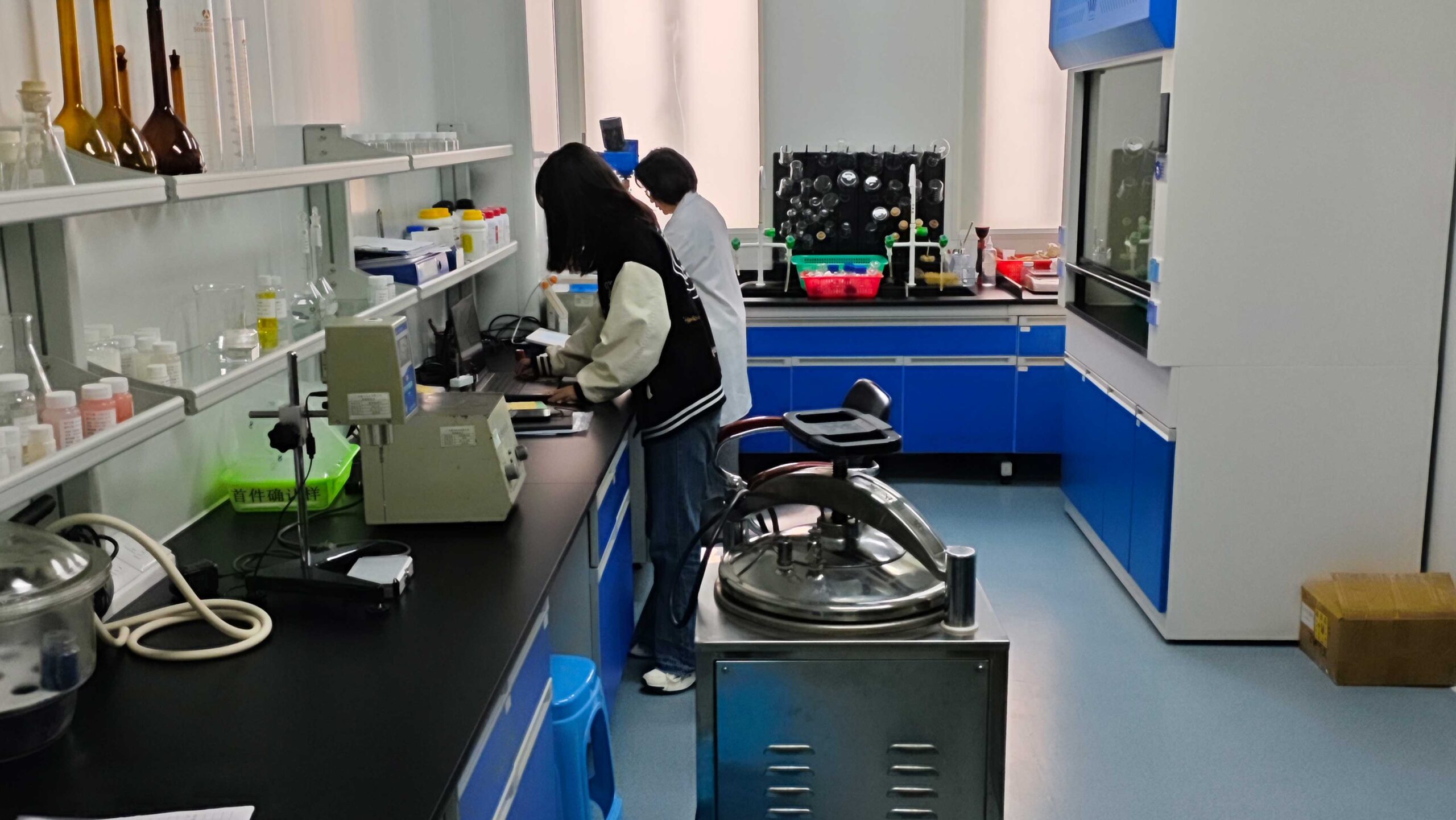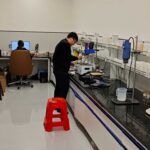Definition and characteristics of acne
Acne, commonly known as pimples, is a common chronic inflammatory skin disease during adolescence. Commonly seen in teenagers and young adults, it mainly occurs in areas with high sebum secretion such as the face, chest, and back.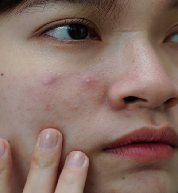
Treatment of acne
With the development of the economy and people’s pursuit of beauty, the quality of skincare products is constantly improving, especially the effectiveness of anti acne and acne removing products in acne treatment is becoming increasingly evident.
The role of skincare products in acne treatment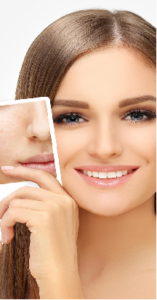
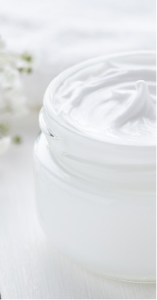
The Importance of Skincare Products
Skincare products play an indispensable role in acne treatment. They can be combined with medication, chemotherapy, and physical therapy to provide a comprehensive and effective treatment experience for acne patients.
The function of skincare products
Skincare products play an important role in acne treatment, as they can deeply cleanse the skin, remove excess oil and dirt, while replenishing the skin’s necessary moisture and nutrients, providing comprehensive care for the skin.
Symptoms of acne
Mild (Grade I) symptoms
Mild (Grade I) is characterized by the appearance of acne on the surface of the skin, which is caused by abnormal keratinization, which is caused by thickening of sebaceous gland epithelial cells. After falling off, cells will connect with sebum, causing blockages in the ducts.
Moderate (Grade II) symptoms
A symptom of moderate acne is usually inflammation or papules. When the hair follicles of the skin are blocked, they become anaerobic, producing a large number of bacteria and microorganisms. After reproduction, these microorganisms produce esterases that remain in the ducts for division, decomposing into triglycerides and free fatty acids. In addition, some chemokines are also produced, leading to the aggregation of white blood cells and the formation of inflammatory papules.
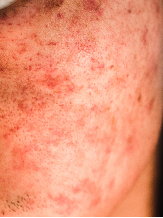
Moderate (Grade III) symptoms
When it reaches moderate (grade III), the symptoms of herpes will be very obvious, mainly because a large number of neutrophils gather in the hair follicle sebaceous glands, and Propionibacterium acnes induces inflammation. If pustules appear, even if cured, they will still leave concave scars.
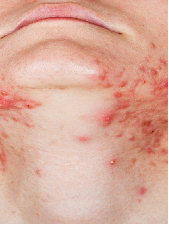
Severe (Grade IV) symptoms
In severe cases (grade IV), cysts and nodules may appear, and excessive accumulation of keratin, sebum, and pus cells in the hair follicle sebaceous glands can damage the structure of the hair follicle sebaceous glands, forming red convex nodules.
Types of Acne Removing Skincare Products
Cleansing products
One of the basic functions of cleansing products is to clean the skin and remove secreted oil. Compared to other skin types, acne prone skin secretes more oil, so many cleansing products need to add some oil controlling substances with strong cleansing oil ability, such as kaolin, PCA zinc, etc. Some facial cleansers currently on the market add a relatively mild and soothing APG surfactant, which has a very gentle degreasing power and is gentle on the skin. It does not irritate the eyes and avoids the possibility of barrier damage caused by excessive cleaning. In addition, in facial cleansing products, some ingredients that soften keratin are usually added, such as organic acids (salicylic acid, malic acid, etc.). In addition, it is also common to add plant extracts with anti-inflammatory, oil controlling, and anti itch effects to facial cleansing products.
Makeup water
After cleansing, we need to moisturize the skin in a timely manner. Acne reducing toners usually add some effective ingredients to repair the damaged barrier. Therefore, active substances such as hyaluronic acid and polyols are usually added to makeup water. In addition, some anti-inflammatory and antioxidant ingredients such as plant extracts such as marigold, acacia, witch hazel, Bordeaux leaves, and centella asiatica extract can be added to makeup water.
Face cream/lotion
The purpose of face cream lotion is to help the skin lock water. face cream or lotion usually adds some Chinese herbal extracts, such as gastrodia elata, sophora flavescens, fructus cnidii, berberine, berberine, etc. These ingredients all have certain effects of inhibiting melanin formation, antioxidant, and antibacterial. For acne patients, it is very necessary to add face cream lotion with moisturizing and light protective ingredients into skin care products. In addition, in the design of acne cream products, it is necessary to avoid heavy oils, emulsifiers or oils that pose a risk of causing acne.
Essence liquid
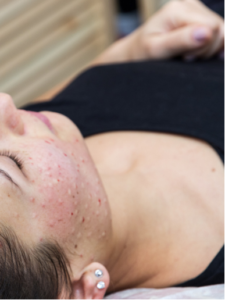 Essence liquid contains many effective ingredients with high content. Salicylic acid is added to many acne essence. Salicylic acid can dissolve oil, penetrate into pores, deeply clean and diminish inflammation, accelerate cutin metabolism, improve skin roughness, reduce acne marks, and also has a certain whitening effect. In addition, ethylene glycol salicylate can also be added to essence solution, which can play the role of anti-bacterial, analgesic and anti-inflammatory, with high safety coefficient and almost no skin irritation. Piaoning, tartanol and colloidal sulfur are also added ingredients in many current essence solutions, which have a strong inhibitory effect on propionibacterium acnes, which causes acne, and can better improve acne and inflammatory acne caused by microorganisms.
Essence liquid contains many effective ingredients with high content. Salicylic acid is added to many acne essence. Salicylic acid can dissolve oil, penetrate into pores, deeply clean and diminish inflammation, accelerate cutin metabolism, improve skin roughness, reduce acne marks, and also has a certain whitening effect. In addition, ethylene glycol salicylate can also be added to essence solution, which can play the role of anti-bacterial, analgesic and anti-inflammatory, with high safety coefficient and almost no skin irritation. Piaoning, tartanol and colloidal sulfur are also added ingredients in many current essence solutions, which have a strong inhibitory effect on propionibacterium acnes, which causes acne, and can better improve acne and inflammatory acne caused by microorganisms.
Facial mask
Some important ingredients are usually added to the acne facial mask to make it directly act on the skin surface, combined with some traditional Chinese medicine fumigation, so that the drug can penetrate the skin for a long time. A common drug is Phellodendron amurense, which is a traditional Chinese medicine with anti-inflammatory, antioxidant, edema reducing and other effects. Adding it to the facial mask can improve some skin damage caused by acne after 8 weeks of use. In addition to Phellodendron amurense, the peeled facial mask made of trehaloplast and inositol can reduce the androgen in the skin of patients with acne and improve the skin symptoms of patients with acne.
Raw materials for acne reducing skincare products
Plant based raw materials
The most common plant-based ingredients are essential oils and plant extracts. In addition to being used as a fragrance ingredient, essential oils are also applied in the production process of acne and skincare products. Many essential oils contain terpene compounds, which have been proven to have antibacterial, antifungal, antiviral, antioxidant, and insecticidal properties. Studies have found that when the amount of tea tree essential oil added is 1%, the growth of 90% of Propionibacterium acnes strains is inhibited; The sesquiterpenes of acacetin also have the effects of inhibiting acne, eliminating body odor and sweat odor, and have mild antibacterial effects. Compared to essential oils, plant extracts are relatively more widely used in skincare products, such as Danshen extract, Sophora flavescens root extract, Huangqin root extract, guava fruit extract, and honeysuckle flower extract. They have antioxidant, antibacterial, and acute anti-inflammatory effects, and have varying degrees of inhibitory effects on various organisms and fungi. They are often widely used in the treatment of skin problems such as acne, rash, and eczema.
Fruit acid
There are about 20 types of fruit acids, among which lactic acid, citric acid, tartaric acid, malic acid, and glycolic acid are commonly used in skincare products. Alpha hydroxy acids are usually applied during the superficial or middle peeling stage of acne treatment. The reason is that it can inhibit the growth of Propionibacterium acnes in and around hair follicle openings, and also alleviate the inflammatory response caused by hair follicle stings. Whether it is the treatment of nodules, papules, or non inflammatory acne, fruit acid has a significant effect.
Salicylic acid
Salicylic acid has a very strong ability to dissolve keratin. It is mainly extracted from willow trees as 2-hydroxybenzoic acid and used as a superficial exfoliating agent for acne treatment. It can promote rapid differentiation and shedding of keratinocytes due to its strong lipophilicity, which can directly act on acne, inhibit bacterial growth, and prevent pore blockage. Due to its characteristics, skincare products containing salicylic acid have a significant effect in treating acne.
Azelaic acid and its derivatives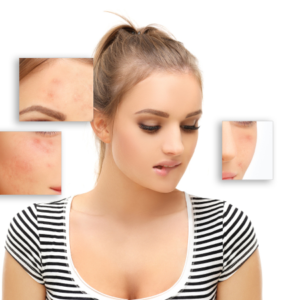
The main functions of azelaic acid and its derivatives include inhibiting bacterial growth, suppressing the production of 5 α – reductase, inhibiting free radical production, reducing the synthesis of filamentous keratin, and disrupting mitochondrial respiration and cellular DNA synthesis, thereby inhibiting the activity of tyrosinase. It has anti proliferative and cytotoxic effects, can reduce melanin production, and whiten the skin.
Enzyme
There are a large number of lytic bacteria in enzymes that can break down the chemical bonds between N-acetyl cysteine and N-acetylglucosamine, and also break down insoluble polysaccharides on the cell wall into soluble glycopeptides, causing the cell wall to rupture. In addition to antibacterial properties, enzymes containing a large amount of proteases and lipases can also be used in cosmetics to clean sebum, unclog pores, avoid blockages, and effectively prevent acne.
Colloidal sulfur
Sulfur has been extensively clinically validated in China as an active ingredient with highly reliable acne and antibacterial properties, and is therefore widely used in medical products such as acne cleansers and ointments. Colloidal sulfur “is a raw material ingredient produced by Vantrus in the United States that can be used in cosmetics. Colloidal sulfur has mild properties and can help the skin clear excess dead skin cells, improve acne and pimple skin texture and blemishes. The sulfur-containing yellow is produced in Texas, USA, and is formed by applying Arabic gum evenly on the surface of sulfur particles through a special process by Vantrus. In the latest human test conducted by Vantrus, 4% to 13% colloidal sulfur products have a certain acne removing effect, but high concentrations can easily cause irritation. Acne creams containing 6.7% colloidal sulfur can effectively improve the acne status of the skin.
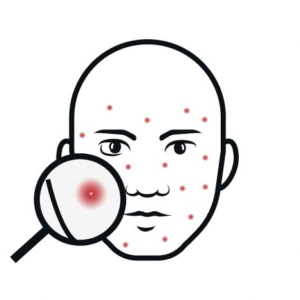
Effect of Acne Removing Skincare Products
Control oil, soften keratin, and tighten pores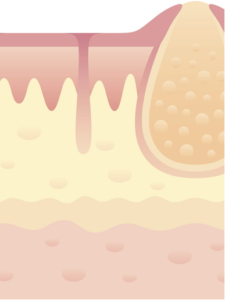
Adding substances with oil control effects to acne reducing skincare products can help alleviate users’ acne symptoms. Some common products on the market for removing acne, combined with oil and keratin treatment agents, can help keratinocytes metabolize quickly, epidermal cells fall off quickly, and also unclog hair follicles. The currently recognized effective ingredient is alpha hydroxy acid. It can assist in the treatment of acne and pigmentation, dissolve the constituent substances in the stratum corneum, and make the stratum corneum easier to shed.
Antibacterial and anti-inflammatory
The current obvious approach and method for treating acne is to inhibit the growth of Propionibacterium acnes. Many experimental results have shown that extracting effective ingredients from plants, such as Forsythia suspensa and Coptis chinensis, can inhibit the growth of Propionibacterium acnes. In drug treatment, antibiotics are usually used to have antibacterial, anti-inflammatory, and sedative effects. The effective substance also inhibits protein synthesis in cells, thereby avoiding bacterial growth. Many acne reducing skincare products add traditional Chinese herbal substances, such as olive leaf extract, curcumin, and centella asiatica glycosides, to achieve the goal of acne removal by utilizing their anti-inflammatory effects.
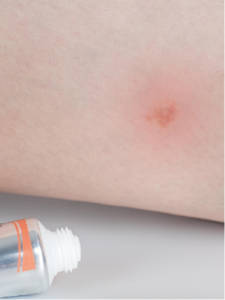
Resolve pigment deposition
The inhibition of melanin can be achieved by blocking the alpha MSH signal, exerting competitive inhibition of tyrosinase, and preventing ultraviolet UVA radiation. Skincare products can be improved with whitening creams such as raspberry ketone glucoside, tranexamic acid, niacinamide, etc., to achieve whitening effects. In addition, ingredients such as arbutin, niacinamide, and nonapeptide can be added to acne products. These ingredients all have the effect of blocking melanin formation, brightening and whitening. It should be noted that arbutin has photosensitivity, and high content may produce photosensitivity. Moreover, niacinamide should be avoided from being used together with acids such as fruit acid and salicylic acid. If used together, poor pH control or high temperature of the product can form niacinamide, causing intolerance reactions such as redness, swelling, and thermal pain. Compared to others, nonapeptide has high stability and does not irritate the skin, making it friendly to all types of skin.

Scar repair
Promoting rapid closure of acne can repair acne prone skin and prevent scar formation. And the functional substances of plant sterols can help repair the connective layer of the true epidermis. Scar repair ingredients can also introduce ingredients such as human like collagen, fibronectin, blue copper peptide, oligopeptide, medical silicone, etc., which can promote epidermal growth and inhibit scar hyperplasia. Human like collagen can penetrate the dermis layer, replenish lost collagen and moisture in the skin, activate cells, promote skin collagen production, and fundamentally repair the skin barrier. Fibronectin has a regenerative effect on the skin. It can act as a chemokine to induce skin cells to migrate to the damaged area, while regulating the proliferation, growth, and differentiation of various cells in the damaged area, inducing orderly growth of skin tissue, and achieving a perfect repair effect without scars or pigmentation. In addition, many cosmetics contain oligopeptides, which are small molecule active peptides that promote skin metabolism and repair damaged skin; Moreover, oligopeptide molecules are relatively small and can be quickly absorbed by the skin.
conclusion
Acne is a skin disease, and patients with acne need to pay more attention to their facial condition and improve the skin environment. Moderate to severe patients need to seek medical attention immediately and take medication under the guidance of a doctor. In addition, on the basis of medication, some acne reducing skincare products can also be combined to repair the patient’s skin condition and prevent pigmentation, scars, etc. in advance.
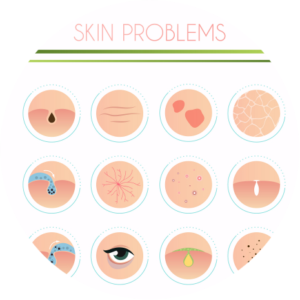
reference:
- Wang Yu, Chen Jianhui, Liao Shendi Research on the pathogenesis of acne and acne related skincare products [J]. Shanghai Light Industry, 2024, 5:165-167
- Chen Xu, Su Shiwen, Niu Yueqing, Characteristics of acne aggravation in premenstrual stage and efficacy of skincare products: a randomized, double-blind trial [J]. Chinese Journal of Dermatology. 2021 (9): 839-840
- He Lingling, Zhang Yi, Gong Qiujun, etc The mechanism and symptoms of acne and the types of efficacy of acne reducing skincare products [J]. Daily Chemical Industry, 2020 (5): 336-342
- Other literature (omitted).
Content source: Metz Medicine

